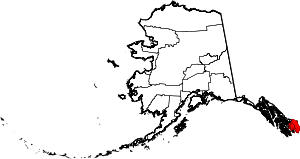Ketchikan, Alaska
Ketchikan (/ˈkɛtʃɪkæn/ KETCH-ih-kan;[7] Tlingit: Kichx̱áan) is a city in and the borough seat of the Ketchikan Gateway Borough of Alaska.[4][8] It is the state's southeasternmost major settlement. Downtown Ketchikan is a National Historic District. With a population at the 2010 census of 8,050,[4] it is the fifth-most populous city in the state, and tenth-most populous community when census-designated places are included. The surrounding borough, encompassing suburbs both north and south of the city along the Tongass Highway (most of which are commonly regarded as a part of Ketchikan, albeit not a part of the city itself), plus small rural settlements accessible mostly by water, registered a population of 13,477 in that same census.[9] Estimates put the 2017 population at 13,754 people.[10] Incorporated on August 25, 1900, Ketchikan is the earliest extant incorporated city in Alaska, because consolidation or unification elsewhere in Alaska resulted in dissolution of those communities' city governments. Ketchikan is located on Revillagigedo Island, so named in 1793 by Captain George Vancouver.
Ketchikan Kichx̱áan | |
|---|---|
City | |
 View from a cruise ship of the Newtown area of Ketchikan. In the foreground is the intersection of Schoenbar Rd. and Water Street. | |
 Flag | |
| Nickname(s): Salmon Capital of the World, Rain Capital of Alaska, Alaska's First City | |
 Ketchikan Location in Alaska | |
| Coordinates: 55°21′00″N 131°40′24″W | |
| Country | |
| State | |
| Borough | Ketchikan Gateway |
| Incorporated | August 25, 1900[1] |
| Government | |
| • Mayor | Lew Williams III[2] |
| • Governing body | City Council |
| • State senator | Bert Stedman (R) |
| • State rep. | Dan Ortiz (I) |
| Area | |
| • Total | 4.90 sq mi (12.70 km2) |
| • Land | 3.81 sq mi (9.88 km2) |
| • Water | 1.09 sq mi (2.82 km2) |
| Elevation | 0 ft (0 m) |
| Population | |
| • Total | 8,050 |
| • Estimate (2019)[5] | 8,284 |
| • Density | 2,172.00/sq mi (838.50/km2) |
| • City and Borough | 13,477 |
| • City and Borough Estimate (2014) | 13,787 |
| Time zone | UTC−9 (AKST) |
| • Summer (DST) | UTC−8 (AKDT) |
| ZIP codes | 99901, 99950[6] |
| Area code | 907 |
| FIPS code | 02-38970 |
| GNIS feature ID | 1423039, 2419408 |
| Website | www |
Ketchikan is named after Ketchikan Creek, which flows through the town, emptying into the Tongass Narrows a short distance southeast of its downtown. "Ketchikan" comes from the Tlingit name for the creek, Kitschk-hin, the meaning of which is unclear. It may mean "the river belonging to Kitschk"; other accounts claim it means "Thundering Wings of an Eagle".[11] In modern Tlingit, this name is Kichx̱áan.[12]
History
.jpeg)
Ketchikan Creek served as a summer fish camp for Tlingit natives for untold years before the town was established by Mike Martin in 1885. He was sent to the area by an Oregon canning company to assess prospects. He established the saltery Clark & Martin and a general store with Nova Scotia native George Clark, who had been foreman at a cannery that burned down.[13]
Totem poles
.jpeg)
Ketchikan has the world's largest collection of standing totem poles, found throughout the city and at four major locations: Saxman Totem Park, Totem Bight State Park, Potlatch Park, and the Totem Heritage Center. Most of the totems at Saxman Totem Park and Totem Bight State Park are recarvings of older poles, a practice that began during the Roosevelt Administration through the Civilian Conservation Corps. The Totem Heritage Center displays preserved 19th-century poles rescued from abandoned village sites near Ketchikan.
Geography
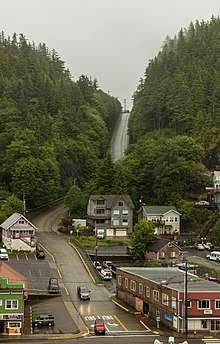
Ketchikan's GPS geographic coordinates are latitude 55.342 (slightly south of both Copenhagen, Denmark at 55.676 and Glasgow, Scotland at 55.864) and longitude -131.648. The city is located in southernmost Southeast Alaska on Revillagigedo Island, 700 miles (1,100 km) northwest of Seattle, Washington, 235 miles (378 km) southeast of Juneau, Alaska, and 88 miles (142 km) northwest of Prince Rupert, British Columbia, Canada. It is surrounded by the Tongass National Forest, which is managed by the United States Forest Service from its headquarters in the Ketchikan Federal Building downtown, and to the south by the Tongass Narrows, a narrow east-west saltwater channel, which is part of the Inside Passage.
Due to its steep and forested terrain, Ketchikan is long and narrow with much of the built-up area being located along, or no more than a few city blocks from, the waterfront. Elevations of inhabited areas range from just above sea level to about 300 feet (91 m). Deer Mountain, a 3,001-foot (915 m) peak, rises immediately east of the city's downtown area.
According to the United States Census Bureau, the city has a total area of 5.9 square miles (15.3 km2). 4.4 square miles (11.3 km2) of it is land and 1.5 square miles (4.0 km2) of it (29.14%) is water.[14]
The half-mile (800 m) wide channel called the Tongass Narrows separates Ketchikan from Gravina Island, where Ketchikan International Airport is located.
Climate
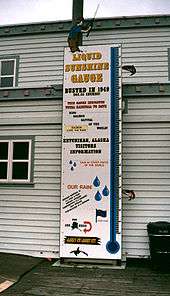
Ketchikan has a mild maritime or oceanic climate, characterized by heavy cloud cover and high humidity through much of the year and abundant rainfall throughout the year (even in the driest month). This location's climate is classified as (Köppen Cfb or Marine West Coast), which is likened to the cities of Aberdeen and Inverness in northern Scotland and Stavanger and adjacent coastal areas, such as Askøy, in Western Norway, though with much more rain, earning it the nickname of the "Rain Capital of Alaska". Winters are cool but milder than its latitude alone may suggest: January has a 24-hour average of 33.6 °F (0.9 °C) with an average daytime high of 38.9 °F (3.8 °C) and overnight low of 28.6 °F (−1.9 °C). Summers are mild, as August's temperature averages 58.4 °F (14.7 °C) with an average daytime high of 65.2 °F (18.4 °C) and overnight low of 51.6 °F (10.9 °C). Rainfall averages 153 inches (3,893 mm) per year, falling more heavily in autumn and winter. On average, the growing season (non-freezing temperatures) lasts about 6.3 months or 191 days, extending from about April 19 to about October 27.
Ketchikan rivals Whittier and Yakutat as the wettest city in Alaska and the United States. (However, with an annual precipitation of 197.8 inches (5.02 m), the city of Whittier receives significantly more annual precipitation than both Yakutat and Ketchikan, which makes it the wettest city in Alaska and the United States, and Yakutat and Ketchikan the second- and third-wettest cities in Alaska, respectively.[15])
Further east and away from moderating maritime influence, winters on these parallels in inland North America are much colder.
The record high temperature in Ketchikan was 96 °F (36 °C) on June 25, 1913. The record low temperature was −7 °F (−22 °C) on January 23, 1916. On January 14, 2018 Ketchikan recorded a high temperature of 67 °F (19.4 °C) which is the highest recorded temperature in Alaska in the month of January. The wettest year was 1949 with 202.55 inches (5,145 mm) and the driest year was 1995 with 88.45 inches (2,247 mm). The most rainfall in one month was 42.69 inches (1,084 mm) during October 1974 and the most rainfall in 24 hours was 8.71 inches (221 mm) on October 11, 1977. The most snowfall in one month was 45.1 inches (115 cm) in January 1971.
| Climate data for Ketchikan, Alaska | |||||||||||||
|---|---|---|---|---|---|---|---|---|---|---|---|---|---|
| Month | Jan | Feb | Mar | Apr | May | Jun | Jul | Aug | Sep | Oct | Nov | Dec | Year |
| Record high °F (°C) | 67 (19) |
63 (17) |
69 (21) |
75 (24) |
93 (34) |
96 (36) |
92 (33) |
89 (32) |
80 (27) |
72 (22) |
65 (18) |
62 (17) |
96 (36) |
| Mean maximum °F (°C) | 49.5 (9.7) |
50.2 (10.1) |
53.4 (11.9) |
62.3 (16.8) |
71.7 (22.1) |
76.4 (24.7) |
78.1 (25.6) |
77.5 (25.3) |
70.8 (21.6) |
60.5 (15.8) |
54.3 (12.4) |
50.5 (10.3) |
81.6 (27.6) |
| Average high °F (°C) | 38.9 (3.8) |
41.8 (5.4) |
44.0 (6.7) |
50.0 (10.0) |
56.4 (13.6) |
61.5 (16.4) |
64.9 (18.3) |
65.2 (18.4) |
59.9 (15.5) |
51.8 (11.0) |
44.5 (6.9) |
40.5 (4.7) |
51.6 (10.9) |
| Average low °F (°C) | 28.6 (−1.9) |
31.1 (−0.5) |
32.1 (0.1) |
36.0 (2.2) |
41.4 (5.2) |
47.3 (8.5) |
51.2 (10.7) |
51.6 (10.9) |
47.3 (8.5) |
40.8 (4.9) |
34.5 (1.4) |
31.1 (−0.5) |
39.4 (4.1) |
| Mean minimum °F (°C) | 13.1 (−10.5) |
17.1 (−8.3) |
20.4 (−6.4) |
27.8 (−2.3) |
33.0 (0.6) |
39.6 (4.2) |
44.4 (6.9) |
44.2 (6.8) |
37.7 (3.2) |
30.2 (−1.0) |
23.4 (−4.8) |
16.5 (−8.6) |
7.3 (−13.7) |
| Record low °F (°C) | −7 (−22) |
0 (−18) |
3 (−16) |
10 (−12) |
25 (−4) |
32 (0) |
36 (2) |
34 (1) |
28 (−2) |
17 (−8) |
5 (−15) |
−1 (−18) |
−7 (−22) |
| Average precipitation inches (mm) | 13.88 (353) |
12.74 (324) |
11.28 (287) |
11.19 (284) |
9.25 (235) |
7.37 (187) |
7.43 (189) |
10.80 (274) |
14.22 (361) |
22.17 (563) |
17.26 (438) |
15.65 (398) |
153.24 (3,893) |
| Average snowfall inches (cm) | 13.3 (34) |
8.9 (23) |
5.4 (14) |
0.8 (2.0) |
0.1 (0.25) |
0 (0) |
0 (0) |
0 (0) |
0 (0) |
0.1 (0.25) |
2.3 (5.8) |
8.6 (22) |
39.5 (101.3) |
| Average precipitation days (≥ 0.01 inch) | 20 | 18 | 20 | 19 | 17 | 16 | 15 | 16 | 19 | 24 | 23 | 22 | 229 |
| Source: [16] | |||||||||||||
Demographics
| Historical population | |||
|---|---|---|---|
| Census | Pop. | %± | |
| 1890 | 40 | — | |
| 1900 | 459 | 1,047.5% | |
| 1910 | 1,613 | 251.4% | |
| 1920 | 2,458 | 52.4% | |
| 1930 | 3,796 | 54.4% | |
| 1940 | 4,695 | 23.7% | |
| 1950 | 5,305 | 13.0% | |
| 1960 | 6,483 | 22.2% | |
| 1970 | 6,994 | 7.9% | |
| 1980 | 7,198 | 2.9% | |
| 1990 | 8,263 | 14.8% | |
| 2000 | 7,922 | −4.1% | |
| 2010 | 8,050 | 1.6% | |
| Est. 2019 | 8,284 | [5] | 2.9% |
| U.S. Decennial Census[17] | |||
Ketchikan first appeared on the 1890 U.S. Census as the unincorporated village of "Kichikan." Of its 40 residents, 26 were Native, 9 were White and 5 were Creole (Mixed Russian & Native).[18] It returned as Ketchikan beginning in 1900 and in every successive census. It incorporated as a city also in 1900.
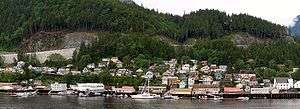
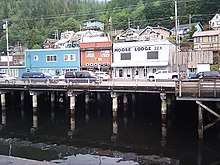
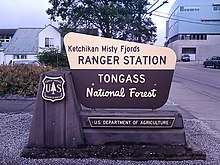
As of 2010, there were 8,050 people, 3,259 households, and 1,885 families residing in the city. As of 2017, The population density was 1,829.5 per square mile (714.1/km2).[19] There were 3,731 housing units at an average density of 848.0 per square mile (330.2/km2). The racial makeup of the city was 60.7% White, 16.7% Native American (8.3% Tlingit-Haida, 1.9% Tsimshian), 10.8% Asian (9.4% Filipino), 10.0% from two or more races, 0.8% Black or African American, 0.3% Pacific Islander, and 0.7% some other race. 4.4% of the population were Hispanic or Latino (2.6% Mexican) of any race.[20][21][22]
.jpeg)
There were 3,259 households. 30.8% had children under the age of 18 living with them, 37.6% were headed by married couples living together, 13.7% had a female householder with no husband present, and 42.2% were non-families. 33.0% of all households were made up of individuals, and 9.0% were someone living alone who was 65 years of age or older. The average household size was 2.41, and the average family size was 3.07.[20]
The population was spread out, with 23.9% under the age of 18, 9.5% from 18 to 24, 26.6% from 25 to 44, 29.3% from 45 to 64, and 10.7% who were 65 years of age or older. The median age was 36.7 years. For every 100 females, there were 103.1 males. For every 100 females age 18 and over, there were 102.5 males.[23]
In 2017, the ACS-estimated median and average annual incomes for a household in the city were $56,372 and $70,490, respectively. The median and average incomes for a family were $68,438 and $84,518, respectively. The per capita income for the city was $30,474. About 12.4% of the population, including 19.8% of those under 18-years old, were below the poverty line.[24] 90.0% spoke English, 5.98% Tagalog, 1.81% Spanish, and 0.7% Tsimshian as their first language.[25]
Media
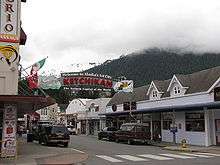
Ketchikan is home to four radio stations: KTKN-AM 930, KGTW-FM 106.7, KFMJ-FM 99.9, and community-owned NPR-affiliated KRBD-FM 105.3.
Ketchikan has one over-the-air broadcast television station, KUBD (TV), Channel 13 digital and 4 visual, a CBS network affiliate.
Ketchikan also houses the publishing offices of the Ketchikan Daily News.
The region has local cable television programming provided by Ketchikan Public Utilities, including public meetings, Southeast Alaska programming, Ketchikan High School sports and events, local history, gardening and scenes, and a calendar of upcoming local events; local television signals carried on the cable system are also translations of Seattle and Anchorage stations.
Government and infrastructure

The City of Ketchikan operates under a council-manager form of government. In 2018, Robert Sivertsen replaced Lew Williams III, who had served 28 years, as mayor[26] of the City of Ketchikan. The Ketchikan Gateway Borough includes both the City of Ketchikan and the City of Saxman and encompasses more than 6,000 square miles (16,000 km2) from the Canada–US border to just south of Wrangell. Rodney Dial is the current Mayor of the Ketchikan Gateway Borough, Alaska. The Alaska Marine Highway System has its headquarters in Ketchikan.[27]
.jpeg)
Ketchikan has long loomed heavy in Alaska's political landscape, though increasing population in Southcentral Alaska has led to a diminishment of its influence since the 1980s. Following a round of redistricting, the convening of the 28th Alaska State Legislature in January 2013 marked the first time in the state's history that no residents of Ketchikan or the surrounding area serve as members of the Alaska Legislature. Ketchikan is represented in the Alaska Senate by Bert Stedman, who lives in Sitka, and in the Alaska House of Representatives by Independent politician Dan Ortiz (politician), a former schoolteacher who taught at Ketchikan High School.
Over the decades, Ketchikan has produced a number of political figures of note to Alaska in general. In territorial days, Norman Ray "Doc" Walker, a Canadian-born pharmacist practicing in Ketchikan, was arguably the first career member of the Alaska Legislature. Walker served in the territorial Senate for 16 years before losing reelection in 1948 following a feud with territorial governor Ernest Gruening. During the first governorship of Walter Hickel in the 1960s, two members of his cabinet (Frank Murkowski and Robert W. Ward) held strong ties to Ketchikan. Following Hickel's resignation, Ward ascended to the office of secretary of state when Keith H. Miller became governor. Ketchikan native Walter L. Kubley, deputy commissioner of commerce under Hickel, became commissioner of the department under Miller. Another Ketchikan native, Terry Gardiner, was notable as the youngest person elected to the Alaska House of Representatives (at age 22), as well as the youngest person elected Speaker of the House (at age 28).
The United States Coast Guard maintains a large shore installation, Coast Guard Base Ketchikan, south of the downtown area, which serves as a homeport to three cutters and as a regional maintenance base for Alaska.
According to the U.S. Postal Service, one of Ketchikan's two zip codes, 99950, is the highest-numbered in the United States.[28]
Economy and industries
.jpeg)
.jpeg)
A major and first port of entry into Alaska, Ketchikan's economy has been based on fishing industries, canneries in particular, tourism, government, and forestry. Average annual civilian employment in 2017 was 4,070, with a substantial seasonal work force peaking in July.
The area near the mouth of Ketchikan Creek earned Ketchikan a measure of infamy during the first half of the 20th century for a red-light district known as Creek Street, with brothels aligned on either side of the creek.
Ketchikan's economy is currently based upon government services, tourism and commercial fishing. Civic boosters have dubbed the community the "Salmon Capital of the World."[29]
Ketchikan also receives a large number of tourists, both by air and sea, due to its popularity as a cruise ship stop. In 2018, Ketchikan Harbour saw 40 different cruise ships making more than 500 stops in the harbour and bringing more than 1,073,000 visitors to Ketchikan.[30]
The Misty Fiords National Monument is one of the area's major attractions, and the Tongass National Forest has long been headquartered in Ketchikan, mostly in the city's historic Federal Building. For most of the latter half of the 20th century, a large portion of Ketchikan's economy and life centered on the Ketchikan Pulp Company pulp mill in nearby Ward Cove. The mill closed in 1997 in the wake of the passage of the Tongass Timber Reform Act of 1990, which reduced timber harvest targets in the national forest.[31]
Lumber
Ketchikan Pulp Company (KPC), a subsidiary of Louisiana-Pacific Corp., was headquartered just outside Ketchikan's city limits on the shores of Ward Cove. The company's pulp mill opened in the cove in 1954. A 1995 joint EPA and FBI investigation of the company revealed it had dumped contaminated wastewater and sludge in the waters around Ward Cove, leaving them classified as "impaired" by the EPA. KPC plead guilty to the charges and agreed to pay a $3 million fine.[32]
In 1996, following the Clinton Administration's refusal to reinstate the original terms of KPC's timber contract, Louisiana-Pacific Corp. announced it would be shutting down the timber mill, and did so in March 1997.[33] A total of 514 direct year-round jobs and more than 500 indirect jobs were lost as a result.[34]
Marine
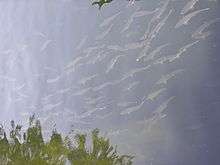
The Ketchikan Shipyard consists of two dry-docks (10,000 ton and 2,500 ton) owned and operated by Alaska Ship & Drydock, a subsidiary of Vigor Industrial. It successfully launched the M/V Susitna in April 2010. A prototype ferry craft for use by Alaska's Matanuska-Susitna Borough, the Susitna is the result of planning by Admiral Jay M. Cohen, former chief of the Office of Naval Research, and former Navy captain Lew Madden, then working as a project manager for Lockheed Martin.
Dubbed E-Craft (for Expeditionary use), the Susitna will serve as the engineering and feasibility platform for a Navy vessel of approximately double the size to assist troops in landing at undeveloped beaches around the world.[35]
.jpeg)
The contract for two new Alaska-class day ferries in the Alaska Marine Highway was awarded to the shipyard on September 20, 2014 at a cost of $101 million.[36]
Power and telecom
Companies involved in power and telocommunication include Ketchikan Public Utilities (KPU), which is city-owned, as well as GCI and Alaska Power and Telephone Company.
Transportation
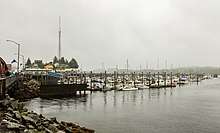
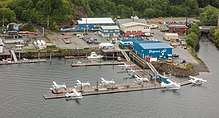
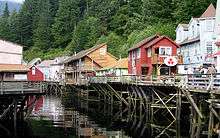
Ketchikan serves as both an air and marine transportation hub for southern Southeast Alaska.
The Ketchikan International Airport serves as both a gateway for Alaska Airlines nonstop jet service to and from Seattle, Juneau, Sitka and Wrangell, with direct service to Anchorage, and as a bush carrier and charter aircraft hub for destinations such as Hyder, Metlakatla and Prince of Wales Island communities. Flying time to/from Seattle, Washington is approximately ninety minutes, making Ketchikan easily accessible to travelers from the continental U.S. Delta Air Lines began operating seasonal service to Seattle in May 2015.
Ketchikan receives service from two separate ferry lines. Ketchikan is a major port along the Alaska Marine Highway System's Inside Passage route. Vessels depart northbound to Alaskan ports of call and southbound to Prince Rupert, British Columbia, a six-hour trip, — where a connection can be made to the BC Ferries system — and Bellingham, Washington, a thirty-six-hour voyage. Sailings depart several times each week.[37] Ketchikan also sees regular day service from the Alaska Marine Highway vessel M/V Lituya, a day boat that shuttles between its homeport in Metlakatla, AK and Ketchikan.
The Inter-Island Ferry Authority serves Ketchikan with daily service from its homeport in Hollis on Prince of Wales Island.[38]
Education
Colleges and universities
The former Ketchikan Community College became the Ketchikan campus of the University of Alaska Southeast during the late 1980s restructuring of the University of Alaska System. The campus is located on the uphill side of Ketchikan's West End neighborhood and consists of two buildings, the Paul Building and the Ziegler Building. Both are named for prominent Ketchikan residents of the early and mid 20th century, William Lewis Paul and Adolph Holton Ziegler, respectively.
Public education
- Ketchikan Gateway Borough School District
- Ketchikan High School
- Revilla Junior/Senior High School
- Schoenbar Middle School
Health care
The city of Ketchikan and its surrounding areas are primarily served by the PeaceHealth Ketchikan Medical Center, which operates 24 hours a day, 7 days a week.
Sister cities and twin towns
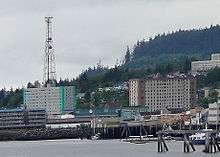


Ketchikan's former sister city of Kanayama, Gifu Prefecture, Japan, was incorporated along with four other cities into the larger city of Gero on March 1, 2004. An educational exchange program has been active between the two towns since 1986. Every year, Ketchikan and Kanayama exchange one teacher each to instruct middle-school level language classes in their respective tongues. In addition, Kanayama sends a group of students to Ketchikan during the spring, and students from Ketchikan travel to Kanayama the following summer. Ketchikan students travel across Japan, with the majority of their time spent in Kanayama with home-stay families, attending classes and touring the town.[39]
Notable people
- Danny Edwards, professional golfer[40]
- Nathan Jackson, Tlingit artist famous for his carving of totem poles[41]
- Roy Jones, first person to fly commercially in Alaska.
- Jerry Mackie, Alaska state legislator and businessman, born in Ketchikan.[42]
- Frank Murkowski, former United States Senator and Governor of Alaska. Murkowski grew up in Ketchikan, where his father was vice-president of the First National Bank of Ketchikan, which exists today as a Southeast regional bank called First Bank.[43]
- Lisa Murkowski, second daughter of Frank Murkowski and his successor as U.S. Senator, born in Ketchikan.[44]
- Rudy Pankow, American actor
- William Paul (Shgúndi), Tlingit statesman and leader in the Alaska Native Brotherhood born near Ketchikan. Paul was the first Alaska Native to become an attorney and first elected to the Alaska Territorial legislature.[45]
- Ray Troll, artist famous for blending art and science in his fish-laden drawings[46][47]
In popular culture
Several movies have been shot in Ketchikan, including The Silver Horde, Spawn of the North, Timber Tramps and Cry Vengeance, plus episodes of the television programs The Love Boat and Baywatch.[48] An episode of Mythbusters where the team sees if a ship made out of ice and sawdust can really float was filmed in Ketchikan in 2009.[49] The National Geographic Channel series Alaska Wing Men in the episode "Fatal Crash"[50] follows a National Transportation Safety Board investigator's site visit of a July 2010 bush pilot fatal crash near Ketchikan.[51]
In The Young Pope TV series, the character Pope Pius XIII as a punishment sends several cardinals who upset him to Ketchikan, which is depicted as a frozen wasteland. In Arthur Miller's play Death of a Salesman, Uncle Ben must leave Willy to go to Ketchikan, where he presumably made part of his fortune.
See also
References
- 1996 Alaska Municipal Officials Directory. Juneau: Alaska Municipal League/Alaska Department of Community and Regional Affairs. January 1996. p. 78.
- 2015 Alaska Municipal Officials Directory. Juneau: Alaska Municipal League. 2015. p. 84.
- "2019 U.S. Gazetteer Files". United States Census Bureau. Retrieved June 30, 2020.
- "Ketchikan city, Alaska". Profile of General Population and Housing Characteristics: 2010 Demographic Profile Data. United States Census Bureau. Archived from the original on February 12, 2020. Retrieved January 22, 2013.
- "Population and Housing Unit Estimates". United States Census Bureau. May 24, 2020. Retrieved May 27, 2020.
- "ZIP Codes by City". United States Postal Service. Retrieved 2013-09-06.
- "Ketchikan". Division of Community and Regional Affairs, Alaska Department of Commerce, Community and Economic Development. Retrieved January 24, 2013.
- "Alaska Taxable 2011: Municipal Taxation - Rates and Policies" (PDF). Division of Community and Regional Affairs, Alaska Department of Commerce, Community and Economic Development. January 2012. Archived from the original (PDF) on 2013-04-25.
- http://quickfacts.census.gov/qfd/states/02/02130.html6%5B%5D
- "Ketchikan Gateway Borough QuickFacts from the US Census Bureau". census.gov.
- "Ketchikan". Britannica.com. 2008-05-12. Retrieved 2010-11-21.
- Edwards, Keri. Dictionary of Tlingit. Juneau: Sealaska Heritage Institute, 2009.
- http://www.sitnews.us/Kiffer/TongassPacking/040707_tongass_packing.html
- "Geographic Identifiers: 2010 Demographic Profile Data (G001): Ketchikan city, Alaska". U.S. Census Bureau, American Factfinder. Archived from the original on February 10, 2020. Retrieved March 26, 2013.
- Whittier – Comprehensive Plan Update 2005 Archived 2015-04-21 at the Wayback Machine, p. 7, September 26, 2005
- "KETCHIKAN, ALASKA (504590)". Western Regional Climate Center.
- "Census of Population and Housing". Census.gov. Retrieved June 4, 2015.
- http://www2.census.gov/prod2/decennial/documents/1890a_v8-01.pdf
- "U.S. Census Bureau QuickFacts: Ketchikan city, Alaska". Census Bureau QuickFacts. Archived from the original on 2018-12-01. Retrieved 2018-12-01.
- Data Access and Dissemination Systems (DADS). "American FactFinder - Results". census.gov. Archived from the original on 2019-05-21.
- "Ketchikan (city) QuickFacts from the US Census Bureau". Quickfacts.census.gov. Archived from the original on 2012-03-03. Retrieved 2012-12-28.
- Data Access and Dissemination Systems (DADS). "American FactFinder - Results". census.gov. Archived from the original on 2020-02-12.
- "Profile of General Population and Housing Characteristics: 2010 Demographic Profile Data (DP-1): Ketchikan city, Alaska". U.S. Census Bureau, American Factfinder. Archived from the original on February 12, 2020. Retrieved March 26, 2013.
- "Selected Economic Characteristics: 2013-2017 American Community Survey 5-Year Estimates (DP03): Ketchikan city, Alaska". U.S. Census Bureau, American Factfinder. Archived from the original on February 10, 2020. Retrieved December 26, 2013.
- "Archived copy". Archived from the original on 2013-08-15. Retrieved 2013-08-07.CS1 maint: archived copy as title (link)
- "Ketchikan city, borough election results certified - KRBD". KRBD. 2018-10-09. Retrieved 2018-12-01.
- "Contact Us Archived 2013-03-30 at the Wayback Machine." Alaska Marine Highway. Retrieved on October 25, 2009.
- "Fun Facts - Postal Facts". about.usps.com. Archived from the original on 2017-02-03. Retrieved 2016-02-13.
- "Pauline Frommer's Alaska". google.com.
- "Visitor Statistics".
- HR 987, 101st Congress, Tongass Timber Reform Act, summary by the Library of Congress.
- "#123 Ketchikan Pulp Co. Pleads Guilty to Environmental Crimes". Justice.gov. 1995-02-06. Retrieved 2011-12-10.
- HighBeam
- http://www.sitnews.us/Kiffer/KetchikanPulpMill/032217_ketchikan_pulp_mill.html
- Buls, Bruce (November 2010). "E-Craft: Cutting-edge vessel design constructed in Ketchikan, Alaska". WorkBoat. pp. 44–51. Archived from the original on 2016-03-03. Retrieved 2019-09-15.
- "Alaska's newest ferries will be built by Alaskans". vigorindustrial.com.
- "Alaska Marine Highway System - Official site of the Alaska DOT&PF". state.ak.us.
- "Welcome To Alaska's Inter-Island Ferry Authority". interislandferry.com.
- "Alaska sister cities index". Gov.state.ak.us. Archived from the original on 2012-02-05. Retrieved 2010-11-21.
- "Danny Edwards". PGA Tour. Archived from the original on October 18, 2012. Retrieved December 10, 2012.
- "Nathan Jackson". National Endowment for the Arts. Archived from the original on October 19, 2012. Retrieved February 13, 2013.
- Alaska State Legislature-Jerry Mackie
- "Governor Frank Murkowski". Alaska Permanent Fund Board Confirmation Committee. Archived from the original on September 21, 2013. Retrieved November 7, 2013.
- "MURKOWSKI, Lisa, (1957 - )". Biographical Directory of the United States Congress. Retrieved November 7, 2013.
- Stephen W. Haycox, "William Paul, Sr., and the Alaska Voters' Literacy Act of 1925"., Alaska History, Vol. 2., No. 1, (Winter 1986/87): 17-38.
- "Artist Ray Troll's creations are filled to the gills". Seattle Post-Intelligencer. 1991-10-22. Retrieved 2009-01-17.
- Sudermann, Hannelore (Spring 2007). "Ray Troll-A Story of Fish, Fossils and Funky Art". Washington State Magazine. Washington State University. Retrieved 2009-01-17.
- "Totem Land Tinsel Town". Sitnews.us. 2005-10-03. Retrieved 2010-11-21.
- Jamie Hyneman. "Can you Build Ships Out of Ice? The Mythbusters Investigate". Popular Mechanics.
- Commercial Development Unit. "Alaska Wing Men - National Geographic". Shop.abc.net.au. Archived from the original on 2012-07-14. Retrieved 2012-12-28.
- "NTSB preliminary report". Ntsb.gov. 2010-07-23. Retrieved 2012-12-28.
External links
| Wikimedia Commons has media related to Ketchikan, Alaska. |
| Wikivoyage has a travel guide for Ketchikan. |


